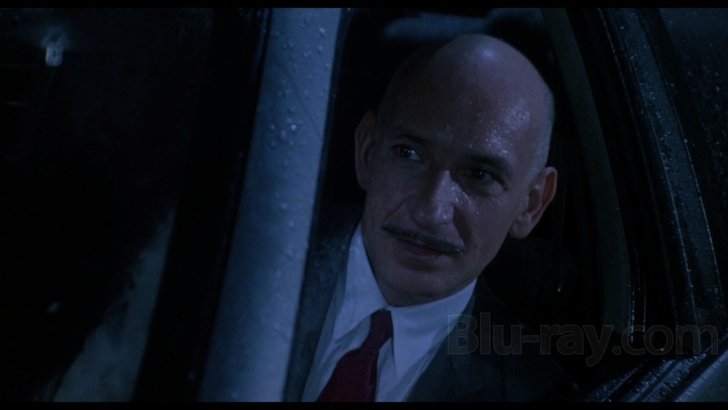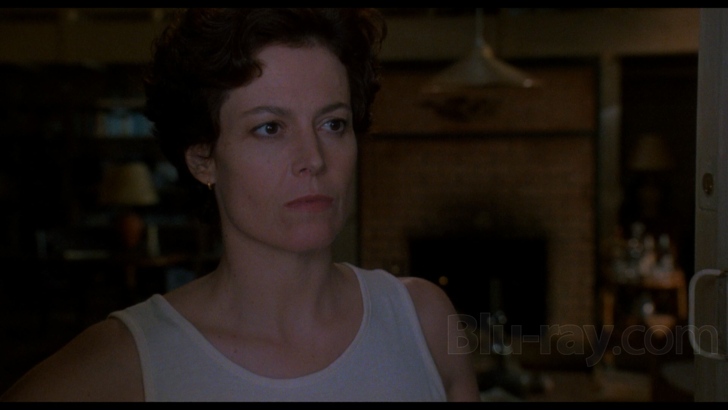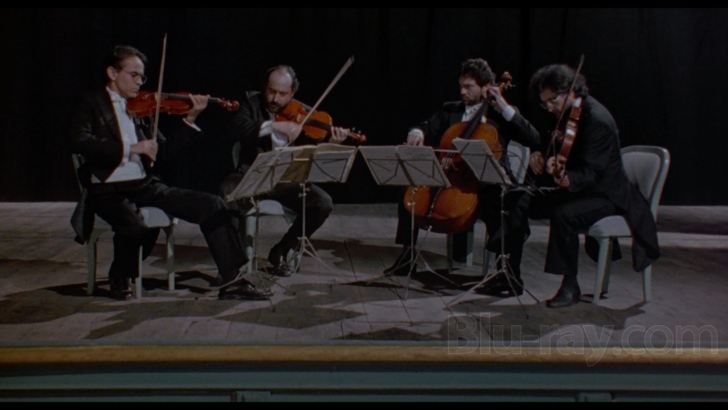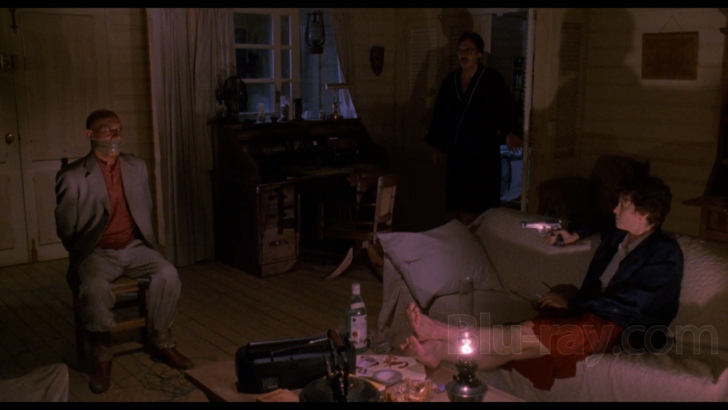Death and the Maiden Blu-ray Movie
HomeDeath and the Maiden Blu-ray Movie 
Shout Factory | 1994 | 103 min | Rated R | Apr 30, 2024
Price
Movie rating
7.4 | / 10 |
Blu-ray rating
| Users | 0.0 | |
| Reviewer | 4.0 | |
| Overall | 4.0 |
Overview
Death and the Maiden (1994)
A political activist is convinced that her guest is a man who once tortured her for the government.
Starring: Sigourney Weaver, Ben Kingsley, Stuart Wilson (II), Krystia Mova, Jonathan VegaDirector: Roman Polanski
| Thriller | Uncertain |
| Drama | Uncertain |
| Mystery | Uncertain |
Specifications
Video
Video codec: MPEG-4 AVC
Video resolution: 1080p
Aspect ratio: 1.85:1
Original aspect ratio: 1.85:1
Audio
English: DTS-HD Master Audio 2.0
Subtitles
English SDH
Discs
Blu-ray Disc
Single disc (1 BD)
Playback
Region A (B, C untested)
Review
Rating summary
| Movie | 4.5 | |
| Video | 4.0 | |
| Audio | 3.5 | |
| Extras | 0.5 | |
| Overall | 4.0 |
Death and the Maiden Blu-ray Movie Review
Reviewed by Dr. Stephen Larson May 10, 2024Note that this review includes several minor spoilers.
When viewers see the first couple reels of Death and the Maiden (1994), they may ask themselves: Why is Paulina Escobar (Sigourney Weaver) so edgy? She appears unsettled while watching a concert performance of Schubert's String Quartet No. 14 in D minor, D 810 (aka Death and the Maiden), her face in anguish. In a recent flashback to her beach house, which sits atop a cliff in an unspecified South American country, Paulina prepares dinner as she anxiously awaits the return of her husband, Gerardo (Stuart Wilson; The Age of Innocence and Lethal Weapon 3), a human rights lawyer. She hears on the radio that Gerardo has been appointed chair of an "Investigating Commission" that will examine crimes committed by a political dictatorship. Paulina becomes flustered. When the electricity goes out, she takes out a revolver from her bedroom as if anticipating a perpetrator will come to her cottage. In a rainstorm, she sees her husband being left off at the beach house by a good Samaritan. Gerardo had a flat tire. Paulina is upset by Gerardo's appointment because she predicts it will be a whitewash. Presumably, it will only look into cases of the deceased and not political prisoners who survived like she did. Later that night, there's a knock at the door and it's the same man, Dr. Roberto Miranda (Ben Kingsley), who took Gerardo home. He's brought a spare tire. Paulina listens intently in the bedroom, covering her mouth with her hand. Does she know the voice of Gerardo's new friend?
After Paulina takes off for a little while, she returns surreptitiously to the house with her husband conked out on the bed and Dr. Miranda laying on the couch. She takes some materials from the kitchen. With the doctor still asleep, she pistol-whips him twice. Paulina ties Dr. Miranda to a chair, gags him, and wraps packing tape around his mouth. Paulina begins to stage her own trial by candlelight and gunpoint. She charges Dr. Miranda with torturing and raping her ca. 1977 when he was allegedly working for a military junta. When Gerardo awakens, he can hardly believe his eyes. What has Paulina done to his new friend? After Gerardo ungags Dr. Miranda and gives him water, the "defendant" is defiant. He protests Paulina's charges, claiming he was out of the country doing his residency in Barcelona. While Paulina clearly recollects what was done to her, does she truly know this Dr. Miranda? After all, she was blindfolded during her whole ordeal.

Paulina: "I don't believe we were ever properly introduced, Dr. Miranda...until now."
Death and the Maiden is based on Ariel Dorfman’s eponymous 1990 stage-play, which was originally published in Spanish as La Muerte y la Doncella. The critically acclaimed work has been performed widely, including as a Broadway production starring Glenn Close, Gene Hackman, and Richard Dreyfuss. The film adaptation, which was co-scripted by Rafael Yglesias (Fearless) and Dorfman, was tailor-made for director Roman Polanski. Like many films by the French-Polish auteur, Death and the Maiden is largely confined to a single setting with a small number of characters. While I have not seen Dorfman’s play performed in person, I have read all of that work's text. I feel that the movie's dialogue is more pithy and succinct. Also, Polanski has a terrific grasp of the material and paces the scenes both methodically and briskly. The film may be a "chamber drama" but it's made cinematic by Tonino Delli Colli's excellent camerawork and Wojciech Kilar's beautifully written score. The performances by Sigourney Weaver and Ben Kingsley are electrifying. Stuart Wilson also puts in admirable work as the conflicted Gerardo, who wants to act as a peaceful mediator between Dr. Miranda and Paulina. While he's understanding and loyal to his wife, he also wants the accused to have rights and a fair say to profess his proclaimed innocence.
Death and the Maiden Blu-ray Movie, Video Quality 

Shout! Studios' limited edition of Death and the Maiden comes on this MPEG-4 AVC-encoded BD-50 (disc size: 29.68 GB). I've seen three transfers of the film, which I'll compare in a moment. But first, it's important to examine the technical aspects of the cinematographic process during the movie's production. According to Polanski biographer Christopher Sandford, the film's ten-week shoot took place at Paris Studios Cinema in Boulogne-Billancourt. Clifftop exteriors were later added on location in northwest Spain. Current American Cinematographer editor Stephen Pizzello interviewed director of photography Tonino Delli Colli and Polanski for a piece that appeared in the magazine's April 1995 issue. Colli told Pizello that he shot the picture using Kodak's 5296 film and the Panavision Gold system. The DP stated that he employed Primo lenses, which were frequently set at 18 mm, 21 mm, 24 mm or 30 mm. Because Polanski prefers the camera to get up close to the actors, Colli incorporated a lot of wide angles (which you can see periodically on the three principal actors throughout the film). In an AC interview with Pizello, Polanski says he worked at 21 mm "quite a bit" and that focal length became the average. The camera crew utilized Panafocal variable-focus zoom, which varies from 18 mm to 23 mm. Polanski says he altered the focus throughout the shot, which would explain why certain facial close-ups sometime appear sharp, while others are soft and fuzzy.
Death and the Maiden is predominantly a dark film that often shows candles, an oil lamp, and a flashlight. Colli remarked to Pizzo that his camera crew utilized little 50- and 150-watt lights to imitate the light of the candles. They toggled back and forth between the different bulbs. This would depend on how close the candles were to the actors. The fixtures needed to be small since they were placed so close to the candles. Colli didn't employ much diffusion. The faces were usually hot because the light was pretty close.
In this same interview, Colli says, "[W]e shot in the 1.85 format." The spherical ratio is not how Death and the Maiden has appeared across its home video releases. For example, in a small rectangular bar on the rear jacket of the 1995 New Line Home Video LaserDisc, it reads: "Death and the Maiden is presented in its original 1.66:1 aspect ratio." It also appears in that AR on a French DVD released by Aventi and TFI. In addition, a French Blu-ray released last year by Tamasa Diffusion reportedly displays the film in 1.66:1. It lists that AR on the back cover, although I can't confirm the framing because I haven't seen the disc. Studio Canal's 2019 German Blu-ray, this Shout! BD, and New Line's R1 DVD all present the movie in 1.85:1. I don't own the SC disc but my research strongly indicates that Shout!'s transfer is a direct port. It should be noted that those two Blu-rays derive from a print that's different from the ones used for the LD and US DVD. For example, this Blu-ray only has the logo of the defunct British distribution company Capitol Films at the start. So, the DI likely derives from a print that was probably shown in Europe when the film originally played. On the other hand, the LD and R1 DVD each come with different Fine Line Pictures logos at the beginning so they're from American prints.
I've assembled screen captures of the three transfers. The 1.66:1 sometimes shows more information in the frame on the top and bottom. The Blu-ray is by far the darkest. It's clearly struck from an older master but still looks crisp and very good overall. Occasionally, but not often, it sports dirt, which you can see on the left side of the frame in Screenshot #8. The DVD is noticeably brighter than the other two. If I were to take an educated guess how accurate the lighting conditions were between the LD and DVD, I would pick the LD. (This was probably how it appeared in US theaters.) However, I don't know how bright or dark the picture looked in European cinemas so I can't determine how accurate the Blu-ray is compared to the EU release prints. Considering how dark the image is on Blu-ray, contrasts are quite good. Shout has encoded the feature at an average video bitrate of 34000 kbps.
Screenshot #s 1-9, 11, 13, 15, 17, 19, 21, 23, 25, 28, 31, 34, 37, & 40 = Shout! Studios 2024 Blu-ray (1.85:1 in 1080p)
Screenshot #s 10, 12, 14, 16, 18, 20, 22, 24, 26, 29, 32, 35, & 38 = New Line Home Video 1995 LaserDisc (letterboxed 1.66:1)
Screenshot #s 27, 30, 33, 36, & 39 = New Line Home Entertainment 2003 DVD (anamorphic 1.85:1)
The 103-minute film receives twelve chapter stops.
Death and the Maiden Blu-ray Movie, Audio Quality 

Shout! has supplied a DTS-HD Master Audio 2.0 Stereo mix (1670 kbps, 24-bit). Death and the Maiden was originally in Dolby Stereo and presented with a Spectral Recording in theaters. I first listened to the PCM Stereo track on the LD and then the DTS-HD MA on the BD. They're definitely different mixes. The LD has superior bass, especially when there's thunderclap and waves clashing at a scenic transition. Clarity and enunciation of spoken words is also better on the LD. The 2.0 mix on the BD was definitely mixed lower. I began listening to both mixes at similar volume levels and found myself going up 5 to 7 decibels to hear dialogue better on the Blu-ray. Even then, I didn't feel it was loud enough, especially compared to the LD (and I have excellent hearing). The Schubert pieces are performed by a quartet and heard on cassette in the film. Wojciech Kilar wrote about 25 minutes of original score. "Paulina's Theme" is instrumentally very diverse. He employs the theme-and-variation method by alternating instruments. Kilar combines that theme with darker material in the form of a string ostinato. "Paulina's Theme" has a rising melodic line that he counterpoints with monophonic-like sounds. There's a piece he composed that presages his music for The Ninth Gate (1999).
Unlike Studio Canal's German BD, this disc comes with optional English SDH for the feature.
Death and the Maiden Blu-ray Movie, Special Features and Extras 

- Theatrical Trailer (1:54, 1080p) - a restored original theatrical trailer for Death and the Maiden presented in 1.85:1 anamorphic widescreen. It uses the MPEG-4 AVC codec (28849 kbps) and comes with DTS-HD MA Stereo sound (1622 kbps).
The LD included a trailer and two TV spots that are virtually identical.
Death and the Maiden Blu-ray Movie, Overall Score and Recommendation 

Death and the Maiden has heavy personal, moral, ethical, and legal implications intertwined with its three characters. I have watched it at least five times and am held spellbound on each viewing. It's one of Polanski's lesser-known works and I hope it continues to gain more recognition. The DI used on this Shout! Studios Blu-ray is struck from a dated master but I believe it looks quite good, although some of the age-related artifacts could be cleaned up in a future restoration (hopefully from an original camera negative). The image is very dark but the picture looks quite solid in 1080p. The DTS-HD MA 2.0 Stereo track is clean and sounds fine, but it could have been mixed louder and with better bass à la the PCM mix on the LaserDisc. There are no extras but on the merits of the film, this earns a STRONG RECOMMENDATION.
Similar titles
Similar titles you might also like

Hannibal 4K
2001

Page Eight
Masterpiece Classic: Page Eight
2011

Pacific Heights
1990

The Evil That Men Do
1984

The Killing Room
Experiment Killing Room
2009

The Ghost Writer
2010

Girls Against Boys
2012

A Dry White Season
1989

Aftermath
2017

Syriana
2005

Apt Pupil
1998

Lipstick
1976

Unlawful Entry
1992

Madame X
1966

Agnes of God
1985

Whispers in the Dark
1992

Unthinkable
2010

Sugar Cookies
1973

Unhinged
2020

Fearless
Warner Archive Collection
1993